 Bomber Command
Bomber Command  |
Aircrew Chronicles
|
Aircrew Losses
|
Nose Art
|
BCATP
|
Lancaster
|
Media
|
Aircrew Chronicles
|
Aircrew Losses
|
Nose Art
|
BCATP
|
Lancaster
|
Media
 Bomber Command
Bomber Command  |
Aircrew Chronicles
|
Aircrew Losses
|
Nose Art
|
BCATP
|
Lancaster
|
Media
|
Aircrew Chronicles
|
Aircrew Losses
|
Nose Art
|
BCATP
|
Lancaster
|
Media
|
Beginning in April 1944, Bomber Command focused on pre-invasion targets, their main goal being to prevent enemy forces in Normandy from being reinforced by rail.
By 5 June (the day before D-Day),
| 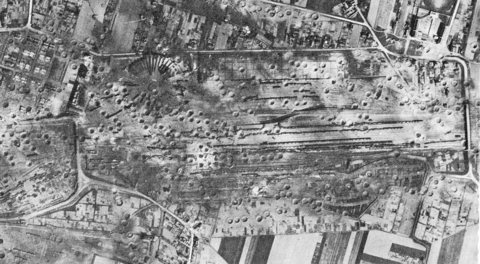 following a Bomber Command raid on 10/11 April |
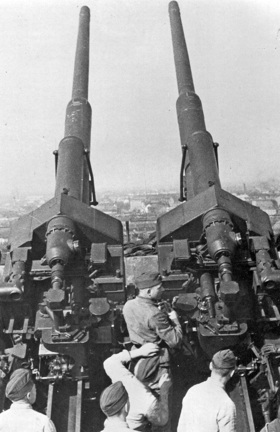
|
Diversion of Nazi Fighters and Field Guns The enemy mounted a massive effort to protect itself from Bomber Command and, later in the war, the American air force. This deprived their army and airforce of vital men and equipment. 75% of their heavy anti-tank guns, manned by 900,000 soldiers, had to be used as anti-aircraft guns, scattered all over Germany because it could not be predicted where the bombers would strike next. Enemy factories had to concentrate on producing aircraft which were used in a defensive role. Scarcely a single enemy aircraft appeared over the beaches during the Normandy Landings. |
These diversions took place to the north of the landing beaches during the night prior to D-Day. They involved bombers flying low over the sea in precise, elongated, overlapping circuits parallel to the coast, gradually closing in toward the shore. 'Window' (strips of aluminum foil that were excellent radar reflectors) was dropped at precisely timed intervals. This created the illusion on shore-based radar that large numbers of ships were approaching.
During the night of 5/6 June, Bomber Command flew 1211 sorties -nearly all in direct support of the invasion forces.
1012 aircraft attacked ten artilley batteries covering the invasion beaches. Due to cloud cover the results were not as successful as was hoped. There were successes however as the following communication sent from the Canadian Army to 6 Group Bomber Command reported, "Three of the four large guns received direct hits while the fourth had its barrel twisted by the blast. This raid undoubtedly saved many lives for which the army is very grateful."
Radio and radar stations were also attacked. Explosives and dummy parachutists were dropped to simulate airborne landings over areas not being invaded.
Tallboys Used to Block the Saumar Tunnel During the night of 8/9 June, 483 bombers attacked railways to prevent enemy reinforcements from reaching Normandy. The first 12,000 pound "Tallboy" bombs were dropped on a railway tunnel near Saumur to block an enemy Panzer unit which was expected to move to the front. Placed with extreme accuracy, the huge bombs exploded under the ground, creating earthquakes that brought down large volumes of rock to block the tunnel entrance. One Tallboy pierced the roof of the tunnel. Later it was calculated that 10,000 tons of earth collapsed into the tunnel which had still not been cleared when the area was liberated in August 1944. |
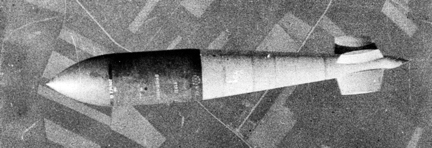 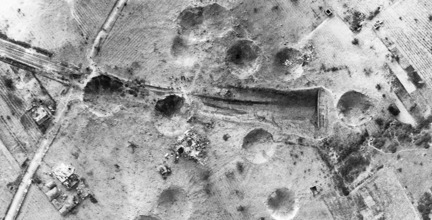 to the tunnel and the one (at right) that penetrated it. |
 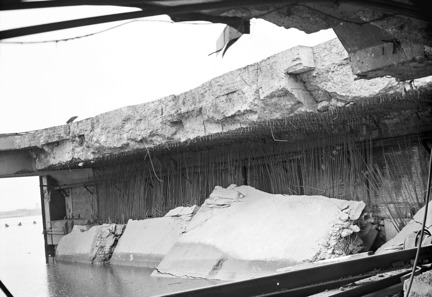 The collapsed roof was caused by the Tallboys. |
Destruction of the E-Boat Fleet The German navy's fast motor-torpedo attack boats had a top speed of over forty knots. They were agile, larger, and more formidable than similar ships built by the British and Americans. The E-Boats based at Le Havre and Boulogne posed a significant danger to the shipping that was supporting the invasion only 50 kilometres away. They were housed in bunkers with re-inforced concrete roofs and walls that were eight to eleven feet thick. Tallboys were again used and when Bomber Command left Le Havre, it was reported that 53 ships had been sunk and only a single E-Boat was operational. Following another successful attack on the Boulogne pens, the Nazis moved the remnants of their E-Boat fleet to Holland. |
Following the landings, Allied armies remained locked in battle with a determined enemy defence for ten weeks before breaking out to sweep towards Germany.
Bomber Command undertook direct bombing of enemy troop and gun positions, ammunition and oil dumps, and rail and road communications to the battle front.
On the day following D-Day, S/L Ian Bazalgette flew one of 122 aircraft that attacked an important 6-way road junction near Caen. The surrounding woods contained fuel dumps and enemy tank units preparing to counter-attack the Allied forces. "Baz" defied orders and bombed from an altitude of only 800 feet with such accuracy that he earned a commendation from the army but a scolding from senior RAF officers.